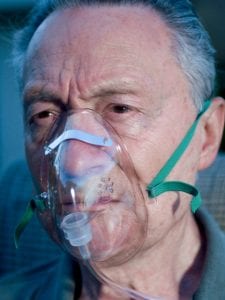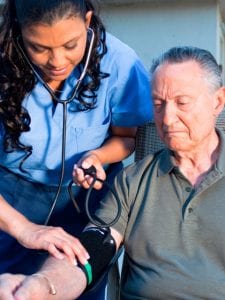Welcome to the educational program Dementia, Delirium, and Depression: Causes and Risk Factors. Delirium and depression are commonly seen in those with dementia, but sometimes it is difficult to understand why. This program will help you understand the underlying causes and risk factors for the various forms of dementia and the causes and risk factors for delirium and depression.
Click here to learn about the similarities and differences between dementia, delirium, and depression, and their treatments, in the previous lesson.
. . .
This is Lesson 2 of The Alzheimer’s Caregiver. You may view the topics in order as presented, or click on any topic listed in the main menu to be taken to that section. We hope that you enjoy this program and find it useful in helping both yourself and those you care for.
There are no easy answers when it comes to the care of another, as every situation and person is different. In addition, every caregiver comes with different experiences, skills, and attitudes about caregiving. Our hope is to offer you useful information and guidelines for caring for someone with dementia, but these guidelines will need to be adjusted to suit your own individual needs.
Remember that your life experiences, your compassion, and your inventiveness will go a long way toward enabling you to provide quality care. Let’s get started.
Prefer to listen to this lesson? Get started by clicking the Play button below.
Dementia
Dementia is a descriptive umbrella term for the long term loss of mental functions, such as memory, thinking and reasoning, caused by various forms of brain damage and diseases. The common underlying element is damage to and loss of brain cells. This damage and loss severely affect the person’s ability to use good judgment, make sound decisions, communicate needs, and carry out activities of daily living. It can affect language skills, recognition, perception, personality, emotional responses, and social behavior.

Some common symptoms of dementia include confusion about the date or time of day, repeatedly asking the same questions, inability to follow directions, getting lost or disoriented in familiar places, lack of recognition or confusion about familiar people, difficulty with routine tasks such as paying the bills, personality changes, neglect of personal safety, hygiene, and nutrition, and difficulty with coordination or balance.
Dementia can be irreversible as is the case with Alzheimer’s disease, or it can be partially or fully reversible if it is caused by a medical condition that is treatable as in the case of some forms of brain, heart, or lung disease. If you or someone you care for has symptoms of dementia, such as confusion, memory difficulties, and impaired function, be sure to consult a physician because the cost may be treatable or it may be possible to slow the progression of the dementia.
Delirium

Delirium is a temporary state of confusion and disorientation that typically develops quickly, within hours to a couple of days. This is referred to as an acute or abrupt onset. Symptoms usually fluctuate, and often include reduced awareness of surroundings and events, perceptual distortions, such as delusions and hallucinations, confused and sometimes loud and belligerent speech, disorganized thought processes that can produce bizarre behavior, and fluctuating level of consciousness. Symptoms usually worsen late in the day, which is known as sundowning. Delirium can last hours or even weeks until the cause is determined and treated.
Delirium is a descriptive syndrome, or a condition, as it has many causes. It is basically a medical condition that has resulted in a toxic state in the brain. Because it represents an acute and severe disturbance of brain functioning, it is considered a medical emergency requiring immediate attention. It can be caused by high fever, infections, medications, dehydration, toxins in the system (such as alcohol), and severe constipation or a fecal infection. It can be worsened by unfamiliar surroundings or people.
It is not unusual for someone with dementia to develop delirium. If a person with dementia has been stable and reasonable in behavior then suddenly changes behavior or mental functioning in a dramatic way, it is possible that she or he is experiencing delirium. The sudden change is usually because something has happened to upset the body’s equilibrium, causing the person to become more confused or frightened. Understanding this, the first response to delirium should be to provide calm reassurance and make sure that the person and caregiver are safe. Then it is important to find out what is causing the delirium and treat it.
Depression

Depression is a mental disorder that typically presents with depressed mood, loss of interest or pleasure, lack of energy or concentration, feelings of worthlessness, guilt, helplessness, or hopelessness, irritability, disturbed sleep and appetite, and thoughts of death.
These symptoms can become chronic or recurrent and significantly affect the person’s health and ability to function. People who are depressed tend to stay in bed or sit around, engaging IN less and less physical activity. For an older person, this lack of activity can contribute to stiffness of joints, loss of strength and flexibility, and loss of general mobility, leading to dependence on wheelchairs and other assistance.
Research has shown that depression also affects the immune system. This means that depressed people are more vulnerable to infections and poor health. This is especially true of older persons who already have lowered immune function and are high risk for lung and urinary tract infections. Older people are especially vulnerable to depression, because of the many losses the experience. They may face loss of loved ones, careers, physical health, independence, mobility, vision, hearing, function, and appearance. The loss of loved ones, friends, and acquaintances can lead to loss of social identity and support networks. Other losses that may cause depression in the elderly include loss of abilities such as driving, shopping, and cooking. These changes affect the person’s self image and sense of independence. Aging also brings about physiologic changes, such as alterations in metabolism and brain chemistry, that contribute to fatigue and slowing of thought processes.
These changes can be difficult for someone to face. Depression and the elderly can present with similar symptoms of dementia. Depressed individuals may have sleep disturbances, such as difficulty falling asleep, nighttime wakening and wandering, and daytime napping. They may neglect their personal hygiene and lose interest in eating and drinking, and similar to dementia, memory concentration and social behavior may be affected.
Because depression and dementia have many symptoms in common. It is important to get a thorough evaluation by a health care professional to distinguish the two as treatments are prognosis are very different depending on the illness.
Case Study 1
Here’s a situation between Mary and her husband, Robert, who was diagnosed with Alzheimer’s about a year ago. What do you think could be the reason for Robert’s behavior?- A) He has a medical condition other than dementia affecting him.
- B) He is frightened by something in the house.
- C) He is having a delusion.
- D) All of the above.
Answers:
Choice A: “He has a medical condition, other than dementia affecting him” could be a possible reason.
A host of medical problems, including heart and lung diseases, infections, medication side effects, and depression can cause rapid worsening of dementia. When changes occur abruptly or even over several days, they need to be investigated, as they could be due to treatable conditions.
Choice B: “He is frightened by something in the house” is a good possibility.
The ability to make sense of one’s surroundings declines with Alzheimer’s, so what may seem perfectly clear to most people, may seem very confusing or frightening for someone with dementia. For example, Mary may hear thunder and immediately know what it is, while Robert, a WWII vet, may think it is cannon fire. If something frightened Robert, he may have grabbed something to use as a weapon to defend himself, which is a natural reaction to danger. Fear and confusion are the cause of many of the behavior problems seen by dementia caregivers.
Choice C: “He is having a delusion” is also a good possibility.
Robert seems to think that someone was stealing from him. People with dementia often believe that others are stealing from or plotting against them because of their feelings of isolation and declining ability to interpret information. Common delusions include people stealing their money or valuables, the spouse having an affair, and people trying to poison them.
Choice D: Because Choices A through C are all good possibilities, Choice D is the best answer.
Causes of Dementia
The main risk factor for dementia is old age. Generally speaking, increasing age is associated with an increasing risk for dementia. Genetic factors are also important for developing dementia diseases. For example, several genes have been identified that increase one’s risk for Alzheimer’s disease.

An often preventable risk factor is severe or repeated head trauma. In some susceptible individuals, head injuries may trigger the disease process. For example, people who receive serious head injuries from boxing are prone to a type of dementia known as dementia pugilistica, which is similar to Alzheimer’s disease. Another modifiable risk factor is education. Less education has been associated with a higher risk for dementia, and higher education has been associated with a protective effect.
Dementia symptoms can be caused by anything that compromises the ability of the brain to function properly, including heart and lung diseases, medications, depression, and, of course, Alzheimer’s disease. When someone begins to have memory problems, the most important thing to do is to consult a physician for a thorough evaluation. It is important to be able to distinguish between changes that are reversible, irreversible, and changes that may worsen and become irreversible.
Irreversible Dementias: Alzheimer’s Disease
Among the irreversible dementias, Alzheimer’s disease is the most common type, accounting for approximately 50% of dementias. Alzheimer’s disease is associated with loss of brain cells in the parts of the brain that control memory and cognitive functions. This loss of brain cells causes an imbalance of chemicals called neurotransmitters, such as acetylcholine, which is decreased in Alzheimer’s disease. As brain cells die, the brain becomes smaller, or atrophies. The areas of the brain that control memory, logical thinking, and personality are generally the most affected. Abnormal proteins called neurofibrillary tangles and amyloid plaques are found in the brain of those with Alzheimer’s.

Research has found genes that are associated with some forms of the disease, and other genes that predispose one to it. Currently, Alzheimer’s is progressive, irreversible, and incurable. However, medications can slow its progression.
Criteria for diagnosing Alzheimer’s disease include memory impairment, poor executive functioning, and one or more of the following: aphasia (or the inability to use or understand language), apraxia (or the inability to make purposeful or coordinated movements, such as dressing), agnosia (or the inability to recognize or identify objects or people). These impairments should represent a decline from baseline functioning and have significant impact on social or occupational functioning. In general, Alzheimer’s disease develops gradually and worsens progressively.
Irreversible Dementias: Vascular Dementias
Vascular dementia is the next most common type of dementia after Alzheimer’s disease, and accounts for approximately nine to 15% of dementias. It encompasses a group of syndromes related to poor circulation of blood to the brain that results in strokes. The three most common types of vascular dementia are multiple cortical infarcts (or multi-infarct dementia), a strategic single infarct, and small vessel disease.
Multi-infarct dementia is the most common form of vascular dementia, and it’s associated with atherosclerosis, hardening of the arteries. Onset of vascular dementia is usually later in life and may be sudden following a single major stroke, or may be gradual following multiple smaller strokes. This form of dementia often shows stepwise progression, with periods of abrupt decline, alternating with plateau periods of no change. Symptoms include changes in behavior such as disinhibition, lack of judgment, and loss of social awareness and insight. In fact, behavior changes are more common than memory problems. Disturbance of emotions, mood, and speech are also frequent. The location in the brain where a stroke occurs accounts for the types of symptoms. Vascular dementia is irreversible and incurable. It is diagnosed based on medical history, symptoms, signs, diagnostic tests, and by ruling out other causes of dementia. The risk factors for this type of dementia include high blood pressure, high cholesterol, smoking, diabetes, mellitus, heart disease, and cerebral vascular or brain vessel disease. Multi-infarct dementia is caused by a series of small strokes due to loss of blood supply, resulting in dead tissue in the brain. Initially, small strokes may not even be noticed by the person or family, but as they accumulate over time, the person will begin to show significant symptoms.
Vascular dementia is often associated with vascular risk factors such as high blood pressure, high cholesterol, cardiac arrhythmias, obesity, and diabetes. From time to time, mini strokes may occur, causing a brief period of confusion and perhaps memory or speech impairment. But because the injury’s small, other blood vessels and brain mechanisms may take over to restore the function so that the symptoms improve. However, if more mini strokes occur, the outcome will be progressive deterioration of mental function following a similar course as Alzheimer’s disease.
Irreversible Dementias: Binswanger’s Disease
Binswanger’s disease is a rare form of vascular dementia that involves the white matter of the brain. White matter is the fatty coating that insulates nerve fibers. In Binswanger’s this coating begins to develop pockets of dead tissue called lacunas, resulting from stenosis or hardening of small blood vessels in the deeper parts of the brain. It progresses in a similar manner as multi-infarct dementia and, in addition to high blood pressure, is often associated with the history of smoking.
This form of dementia is associated with psychiatric symptoms including depression, delusions and hallucinations, as well as losses in memory, speech, self-care skills, and recognition of objects and people.
Alcohol-Related Dementia
Alcohol-related dementia accounts for 10% or less of all cases of dementia in the 65+ age range. It results from prolonged and sustained drinking of alcoholic beverages. Individuals with alcoholic dementia may also have a history of head trauma from falls while intoxicated, which may contribute to the symptoms of dementia.
Other contributing factors include nutritional deficiencies, particularly thiamine (or vitamin B1), folate, and B12. Alcoholics also have multi-organ diseases, such as cirrhosis of the liver. The symptoms of alcoholic dementia resemble Alzheimers disease with short-term memory impairment, apathy, slowed thought processes, and impaired judgment. Alcohol blackouts, seizures, delirium tremens (or DTs) are common precursors of alcoholic dementia.
Persons with alcoholic dementia should abstain from further alcohol intake, eat food with high nutritional content, and take vitamin supplements, especially the B vitamins. These steps may at least stop further progression of the dementia and may even restore some function. As they regain function, people with alcoholic dementia are at risk of resuming heavy drinking. Long-term treatment of the alcoholism and rehabilitation of the individual’s life, that involves family if possible, is necessary to prevent a return to drinking.
Wernicke’s Encephalopathy
 Wernicke’s encephalopathy is a condition of mental confusion, uncoordinated movement, and eye disturbances due to a deficiency of thiamine or vitamin B1 and is often associated with excessive alcohol intake. The condition is reversible if adequately treated with intravenous thiamine. The person also must abstain from alcohol and have adequate nourishment.
Wernicke’s encephalopathy is a condition of mental confusion, uncoordinated movement, and eye disturbances due to a deficiency of thiamine or vitamin B1 and is often associated with excessive alcohol intake. The condition is reversible if adequately treated with intravenous thiamine. The person also must abstain from alcohol and have adequate nourishment.
If the person doesn’t respond to treatment, they can develop Wernicke-Korsakoff syndrome, also referred to as Korsakoff psychosis or alcohol amnestic disorder. This is a chronic condition characterized by amnesia of events before and after the brain damage, squinting, walking problems, disorientation and confabulation. Confabulation means to make up information or events to fill in gaps in memory. It is not intentional as in lying. People with Wernicke’s encephalopathy may also show changes in behavior such as apathy, inactiveness, and loss of insight.
Pick’s Disease or Fronto-temporal Dementia
Fronto-temporal dementia is rare and accounts for only three to five percent of all dementia. It can occur in individuals as young as 40 and is more common among women. This form of dementia is caused by damage to the frontal and temporal lobes of the brain.

The frontal lobe is in charge of executive functions such as reasoning, judgment, decision-making, and personality. The frontal lobe also controls a person’s social graces and impulses. Because the greatest damage is in this area, behavior and personality changes usually occur before memory loss and language problems. People with this Fronto-temporal dementia often present with disturbing behaviors such as aggressiveness, uninhibited and overt sexual behaviors, poor personal hygiene and dress, apathy, compulsive or repetitive behaviors, stealing, and inappropriate language. Speech is affected if the left side of the brain is the damaged.
Later in the illness, the disease will affect other cognitive functions including memory, automatic skills, and recognition. The behavior seen in fronto-temporal dementia can also occur in Alzheimer’s disease, but in Alzheimer’s, these behaviors usually appear later in the illness.
Lewy Body Dementia

Lewy body dementia is caused by abnormal clumps of protein called Lewy bodies that build up in brain cells and kill them. It affects older people, but may develop five to seven years earlier than Alzheimer’s disease and can progress more rapidly. Lewy body dementia is more likely to affect thinking, attention, and concentration rather than memory and language. Hallucinations are common and delusions may be present. Additional symptoms include a tremor and muscle rigidity.
Symptoms may fluctuate from day to day, but it is irreversible and incurable. Some of the drugs used to treat Alzheimer’s disease may also benefit those with this form of dementia. At present, there are no known genetic causes or risk factors for Lewy Body disease.
Parkinson’s and Huntington’s Disease

Parkinson’s disease is a form of Lewy body disease. It is a progressive, incurable disease involving a part of the brain that affects motor control. There is a decrease in the neurotransmitter dopamine, which is important for the brain’s control of muscle activity. Symptoms of Parkinson’s disease include a tremor at rest, stiffness in limbs and joints which causes people to shuffle when they walk, difficulty in initiating physical movements, and speech problems. Dementia may develop late in the disease, but not everyone with Parkinson’s disease has dementia. Reasoning, memory, speech and judgment are most likely to be affected. Parkinson’s disease may be caused by genetic mutations, toxins, such as pesticides, or head trauma.
Huntington’s disease is an inherited degenerative brain disease that causes involuntary movement of the face and limb muscles. Mental symptoms include memory and speech problems, disorientation, intellectual decline, impaired judgments, and personality changes. The disease usually begins during midlife and is irreversible and incurable. The condition is rare with the prevalence of one in 500,000. Children of an affected parents have a 50% chance of inheriting the disease. It is passed down through a specific gene mutation of chromosome 4.
Creutzfeldt-Jakob Disease and HIV/AIDS
Creutzfeldt-Jakob Disease (or CJD) is an uncommon infectious disease caused by the accumulation of an abnormal protein called prion in the brain. Prions cause rapid destruction of brain cells and therefore rapid progression of the disease. Symptoms include memory impairment, dramatic behavior changes, tremor, involuntary movement, and loss of coordination and balance. The person may become visually impaired, develop weakness in the limbs, and lapse into a coma. Death within one to two years of the onset of clinical symptoms is common.
Most cases of CJD are sporadic but 5% to 15% are inherited. A person can get CJD from certain medical procedures involving contaminated material, such as cornea or graft tissue from someone who had the disease. Some people have gotten CJD from receiving contaminated human growth hormone and improperly cleaned surgical instruments. A slightly different form of prion is found in infected cows and is called bovine spongiform encephalopathy. People who eat contaminated beef can also become infected by the BSE prion, but no one knows how the prion crosses species.
HIV or AIDS dementia complex is one of the most common brain complications of late HIV-1 infection. Depending on the severity, it causes three categories of dysfunction: cognitive, motor, and behavioral. Psychosis may also be a symptom. Risk factors and treatment are related to the HIV infection.
Mixed Dementia

A person may have two or more types of dementia (or mixed dementia) with one type usually dominating. Studies suggests that there may not be distinct boundaries between the different types of dementias. For instance, there is a strong interaction between Alzheimers disease and vascular dementia. Some researchers suggest that these two represent parts of a spectrum of dementias. Understanding mixed dementias is important because they may require a different approach to medical management and the separate dementias alone.
Reversible Dementias

Reversible dementia can be caused by chronic medical conditions, such as emphysema or other obstructive lung diseases and certain heart diseases. In these cases, the common cause of dementia is lack of oxygen to the brain. In obstructive lung diseases, the exchange of oxygen and carbon dioxide in the lungs is reduced. When the heart is not working efficiently, such as with congestive heart disease, the transport of oxygen and nutrients to brain function is limited. Other causes of reversible dementia include an imbalance of thyroid hormones and diseases of the kidney and liver. Kidney and liver diseases affect the metabolism of fluids, food, and medications, which leads to the buildup of toxins that can damage the brain.
Mild Cognitive Impairment (MCI)

Mild cognitive impairment (MCI) is a mild loss of memory that often precedes Alzheimer’s disease. It can also involve other areas of mental functioning, such as language, reasoning, and judgment. People with MCI may score poorly on memory tests, but the memory loss is usually not severe enough to affect functioning. Many individuals with MCI eventually develop Alzheimer’s disease. The brain changes seen with MCI are often milder versions of the changes seen in other forms of dementias, that is there may be shrinkage of the hippocampus with beta-amyloid plaques and neurofibrillary tangles composed of tau proteins, as seen in Alzheimer’s disease. There may be evidence of strokes as seen in vascular dementia, or there may be Lewy bodies as seen in Parkinson’s disease. Risk factors include high blood pressure, diabetes, sedentary lifestyle, mental inactivity, fewer years of education, and the APOE gene.
There is tremendous research to prevent or slow the progression of MCI to dementia. One challenge is in distinguishing mild MCI from the process of aging. Aging itself causes changes in mental abilities. First, the speed of thinking and other mental processes declines with aging. For example, learning new information and performing mental activities such as math are slower among older adults. Second, recalling the names of things, places, and people becomes more difficult. However, the functions that do not decline are vocabulary, retaining old information, logical thinking, reasoning, judgment, decision-making, and other executive functions. These are the abilities that make up the wisdom attributed to aging.
Causes of Delirium
Delirium can be caused by many things. Factors that increase the risk of developing delirium include older age, dementia, pain, certain medications, alcohol and drug dependence, vision or hearing impairment, and a number of brain and medical conditions, such as congestive heart failure or kidney failure.
The changes associated with aging can make older people more susceptible to delirium. As people get older, the ability to maintain equilibrium or homeostasis of body systems declines. That means that a breakdown of, say, kidney function will be somewhat more difficult to correct. The immune response in an older person is also less effective, so that a wound infection, for example, may take longer to heal. In addition, older people suffer great losses of their capacities and support systems. This can erode self-confidence and change the perception of the physical and human environment, making the world appear less friendly and even frightening.
Delirium Risk Factors: Brain Conditions
Brain conditions can increase susceptibility to delirium through direct damage to the brain or compromise of its function. Head trauma, bleeding in the brain or head, brain infections (such as meningitis, encephalitis, HIV, or neurosyphilis), seizures, strokes, hypoxemia (or low oxygen in the blood), hypercapnia (high carbon dioxide in the blood), and dementia can predispose someone to delirium. Sleep deprivation can also lead to delirium through a complex mechanism.

Having a diagnosis of Alzheimer’s disease or other form of dementia can make a person more vulnerable to delirium. People with dementia are less able to interpret and understand their environment, which can result in fear and frustration. They may also have poor communication and functional abilities, which limits their ability to meet their needs and express their thoughts. The brain of someone with dementia is in a precarious state at baseline so the addition of pain, a stressful experience, high fever, or toxin to the brain can tip the balance towards delirium.
Many older people including those with dementia have poor vision and hearing. These sensory losses limit people’s ability to understand their environments and the activities occurring around them, causing them to be more easily frightened by a change in routine or the environment, or an unfamiliar person or noise. All these factors can increase the risk of developing delirium.
Delirium Risk Factors: Medical Conditions
Heart and lung disease can increase the risk for delirium by affecting the delivery of oxygen to the brain. Congestive heart failure, heart attacks, and arrhythmias all compromise the ability of the heart to pump an adequate supply of oxygen and nutrients to the brain and remove waste and toxins from the brain. Physical shock also decreases the flow of blood to and from the brain. COPD (chronic obstructive pulmonary disease) and respiratory failure will impair the exchange of oxygen and carbon dioxide in the lungs, limiting oxygen to the brain and allowing the buildup of carbon dioxide.

Several metabolic conditions can also predispose someone to delirium by disrupting the balance flow of oxygen and nutrients to the brain and waste and toxins away from the brain. Kidney failure and liver failure hinder the body’s ability to metabolize and rid the body of waste and toxins that could be damaging to the brain. Electrolyte or salt imbalance, malnourishment, and vitamin deficiency (such as of B12, folate, or thiamine) can hinder brain function and cause delirium. Anemia can also predispose someone to delirium by reducing the blood’s capacity to carry oxygen and nutrients to the brain. Lastly, diabetes mellitus, hyperthyroidism, and hypothyroidism can cause hormone imbalances that can lead to delirium.
Because so many medical conditions can contribute to delirium, it is very important to treat and control all medical issues.
Delirium Risk Factors: Trauma and Illness
Physical trauma, such as surgery or an injury, can be very disorienting. The loss of blood, mobility, consciousness, and confidence can precipitate a delirium. Even an elective surgical procedure can be a traumatic experience due to the unfamiliar environments, anesthesia, pain, and changes in the body. Delirium in elderly people following hip fractures or surgery is a frequent occurrence. The immobility, dependence, pain, and loss of functional ability can be psychologically devastating. Infections (such as urinary tract infections and pneumonia), cancer, and fever due to any cause can cause delirium. Infections and cancer can affect the body’s metabolism, release toxins, and cause fevers.

Elderly people are more susceptible and sensitive to body temperature changes, because aging decreases the body’s ability to regulate temperature. This can mean that the body cannot lose heat by sweating, and temperatures can rise quickly, which can lead to delirium and brain damage. Fever can be caused by trauma or a foreign substance entering the body and triggering an inflammatory or immune response. Examples of trauma include broken bones, bruises, cuts, or surgery. The foreign substance can be an infectious organism, toxic drug, or foreign body such as a bullet or splinter. As the fever rises, it affects the metabolic processes of the body. It is believed that delirium is related more to how fast the fever increases than to how high it is. On the other hand, hypothermia or low body temperature can also cause delirium.
Other causes of delirium include urinary retention and fecal impaction. The delirium could result from the stress of the retention, fluid and electrolyte imbalance, or the imbalance of a substance called porphyrin which is involved in the transport of oxygen in the blood. Because these conditions are common in older people, they should always be considered when delirium occurs.
Delirium Risk Factors: Drugs

Drug intoxication (or intoxication confusional state) is responsible for up to 20% of delirium cases, either from side effects, overdose, substance abuse, or substance withdrawal. Medications that are prescribed for depression, hyperactivity, schizophrenia, or other psychiatric illness are considered to be psychoactive drugs. These drugs are sometimes prescribed for behavior problems in dementia treatment. They can have a powerful effect on the brain and, though prescribed for good reasons, can also make the person more vulnerable to delirium.
All medications have side effects some more dangerous than others. When a person is taking several kinds of medication, referred to as polypharmacy, the medications can interact with each other, either to increase or decrease their effect, or to produce a new and possibly extreme reaction. Therefore, people taking many medications should be closely monitored for drug-drug interactions such as delirium.
Withdrawal from drugs can also cause delirium. For example, withdrawal from alcohol dependency can cause delirium tremens (or DTs). Although rare, DTs usually begin 24 to 72 hours after reducing alcohol intake and can persist for a few hours or up to a few weeks. It can be fatal if not treated and so is a medical emergency.
Delirium Risk Factors: Drugs (Continued)

Medications that have delirium as a possible side effect include: anticholinergics (including atropine, scopolamine, chlorpromazine, and diphenhydramine, an antihistamine); sedatives (including barbiturates, benzodiazepines, and ethanol, drinking alcohol); antidepressants; anticonvulsants; nonsteroidal anti-inflammatory drugs (or NSAIDs), including ibuprofen and acetaminophen; corticosteroids, including prednisone; anticancer drugs, including methotrexate and procarbazine; lithium; cimetidine; and l-DOPA.
Psychoactive drugs that can predispose users to delirium include: ethanol (drinking alcohol); marijuana; LSD (lysergic acid diethylamide) and other hallucinogens; amphetamines; cocaine; opiates, including heroin and morphine; PCP (phencyclidine); and inhalants.
Poisons that can also cause delirium or toxic encephalopathy include: solvents such as gasoline, kerosene, turpentine, benzene, and alcohols; carbon monoxide; freon; heavy metals such as lead, mercury, and arsenic; insecticides (such as parathion and sevin); mushrooms (such as the amanita species); and plants such as jimsonweed and morning glory.
Lastly, animal venoms can also cause delirium.
If a person develops delirium, it is important to review the current list of medications and all recent exposures to toxins and drugs.
Causes of Depression
 The greatest risk factors for depression include a personal or family history of depression, increasing medical issues, substance abuse, and lack of support systems. Older people are especially vulnerable to depression because of the many losses they experience. They may face the loss of loved ones careers, physical health, independence, responsibilities, mobility, vision, hearing, and appearance. The loss of loved ones, friends, and acquaintances can lead to loss of social identity and support networks. Other losses that may cause depression in the elderly include loss of ability such as working, driving, shopping, and cooking. These changes affect the person’s self image and sense of independence. It is easy to feel useless and purposeless.
The greatest risk factors for depression include a personal or family history of depression, increasing medical issues, substance abuse, and lack of support systems. Older people are especially vulnerable to depression because of the many losses they experience. They may face the loss of loved ones careers, physical health, independence, responsibilities, mobility, vision, hearing, and appearance. The loss of loved ones, friends, and acquaintances can lead to loss of social identity and support networks. Other losses that may cause depression in the elderly include loss of ability such as working, driving, shopping, and cooking. These changes affect the person’s self image and sense of independence. It is easy to feel useless and purposeless.Another risk factor for depression includes increasing health issues. Illness, chronic pain, disability, and changing body image due to disease or surgery increase the risk of depression. Some of the more common contributors to depression are the side effects of the many medications older people take for chronic diseases. For example, diuretics and digitalis-based medications reduce the effects of some natural mood-regulating chemicals in the body. With aging also comes fears of dying, health problems, and financial concerns. Aging also brings about physiologic changes in metabolism and brain chemistry that contribute to fatigue and the slowing of thought processes. During these difficult times, social isolation, loneliness and lack of support systems further increase the risk of depression among the elderly.
In the United States, gender plays a role in depression, as women are about as twice as likely as men to be diagnosed and treated for major depression. Marital factors, such as being unhappily married, also can put a person at risk.
While clinical depression usually occurs for the first time when a person is between the ages of 20 and 50, people over the age of 65 may be especially vulnerable, particularly if they have had previous episodes of depression. According to some estimates, approximately one-half of those who develop depression will experience it again. Many of these risk factors are things that can be changed with the help of caregivers, friends, family, therapist, and other health care professionals.
Summary
In summary, there are many forms of dementia — irreversible and reversible. The causes and risk factors for dementia include older age, genetics, history of head trauma, lower education, the risk factors for heart and vessel disease, many reversible and irreversible medical conditions, infections, medications, alcohol and other drugs, and nutritional deficiencies.
The causes and risk factors for delirium include older age, dementia, vision and hearing impairment, pain, fever, trauma, illness, numerous brain conditions, medical conditions, stress, drugs, and toxins.
The causes and risk factors for depression include factors associated with aging, family or personal history of depression, medical issues, pain, disabilities, medication side effects, substance abuse problems, social factors, financial concerns, and being a woman.
As you can see, many of these risk factors are preventable or treatable so you have some control over dementia, delirium, and depression.
← Previous Lesson (Dementia, Delirium, and Depression: Similarities, Differences, and Treatments)
→ Next Lesson (Assisting with Activities of Daily Living: Bathing and Showering)
. . .
Written by: Written by: Catherine M. Harris, PhD, RNCS (University of New Mexico College of Nursing)
Edited by: Mindy J. Kim-Miller, MD, PhD (University of Chicago School of Medicine)
References:
- Alzheimer’s Association. (2007). FDA-approved treatments for Alzheimer’s. Retrieved on December 25 from http://www.alz.org/national/documents/topicsheet_treatments.pdf.
- Birren, J., &Cochran, K., (2001). Telling the stories of life through guided autobiography. Johns Hopkins University Press. Baltimore.
- Ble A, Zuliani G, Quarenghi C, Gallerani M, & Fellin R. (2001). Cystocerebral syndrome: a case report and literature review. Aging (Milano). 13(4):339-42.
- Burnside, I., (1978). Working with the elderly: Group process and techniques. Duxbury Press. North Scituate, MA.
- Butler,R., (1963). The life review: an interpretation of reminiscence in the aged. Psychiatry, 26:65-76.
- Compton MT, Kotwicki RJ. (2006). Responding to Individuals with Mental Illnesses. Sudbury, MA. Jones and Bartlett Publishers. Depression Guideline Panel, 1993, DHHS
- Daiello LA. (2007). Current issues in dementia pharmacotherapy. Am J Manag Care. 13 Suppl 8:S198-202. Greenfield, SA. (1997). The human brain. Basic Books. NY, NY.
- Hill C. (2008). Treatment of Alzheimer’s. About.com. Retrieved on October 1, 2008 from http://alzheimers.about.com/od/treatmentofalzheimers/a/treatments.htm.
- Health-cares.net. (July 18, 2005). What’s the treatment for dementia? Retrieved on October 1, 2008 http://neurology.health-cares.net/dementiatreatments.php.
- Holtzclaw, BJ. (2001). Risk for altered body temperature. In ML Maas, KC Buckwalter, MD Hardy, T Tripp-Reimer, MG Titler & JP Specht. Nursing Care of Older Adults. Diagnoses, Outcomes, & Interventions. Mosby. St Louis. p 201-216.
- Joosten E (2001). Homocysteine, vascular dementia and Alzheimer’s disease. Cllin Chem Lab Med 39(8): 717-720.
- Keltner NL, Folks DG, Palmer CA, & Powers RE, (1998). Psychobioligical foundations of psychiatric care. Mosby. St Louis
- Leenaars, A., Maris, R., McIntosh, J., & Richman, J. (1992). Suicide and the older adult. Guilford Press, NY.
- Malm M. (1980). Fundamentals of Organic and Biochemistry. D. Van Norstrand Comapany. New York.
- Mazza M, Capuano A, Bria P, et al. (2006). Ginkgo biloba and donepezil: a comparison in the treatment of Alzheimer’s dementia in randomized placebo-controlled double-blind study. Eur J Neurol. 13:981-5.
- McIntosh, JL, (2004). USA Suicide: 2004 official final data. CDC WISQARS. cdc.gov/ncipc/wisqars
- Meninger Clinic. (2007). Depression most often confused with Alzheimer’s. Senior Journal. seniorjournal.com/NEWS/
- Merck Manual of Geriatrics. (2000). Delirium. Chapter 39.
- Moraga, AV, Rodriguea-Pascual, C. (2007). Accurate diagnosis of delirium in elderly patients. Current Opinion in Psychiatry. 20(3) p 262-267.
- National Institute on Aging. (2008) Alzheimer’s disease medications fact sheet. http://www.nia.nih.gov/Alzheimers/Publications/medicationsfs.htm.. Retrieved on October 1, 2008.
- Nourhashemi F, Gillette-Guyonnet S, Andrieu S. (2000). Alzheimer’s disease: protective factors. 6435S-6439S.
- Reese, JL (2001). Fluid volume deficit. In M.Maas, K. Buckwalter, MD Hardy, T. Tripp-Reimer, MG Titler & JP Specht. Nursing Care of Older Adults. Diagnosis, Outcomes and Interventions. Mosby. St. Louis. p 183-200.
- Riggs K, Spiro A, Tucker K, Bush D, (1996). Relations of vitamin B12, vitamin B6, folate and homocysteine to cognitive performance in the Normative Aging Study Am. J Clin Nutr. 63: 306-314.
- Robinson R. (2006). Delirium. Gale Encyclopedia of Medicine. Retrieved on December 27, 2008 from http://www.healthatoz.com/healthatoz/Atoz/common/standard/transform.jsp?requestURI=/healthatoz/Atoz/ency/delirium.jsp.
- Roman GC, Sachdev P, Royall DR, Bullock RA, Orgogozo J, Lopez-Pousa S, Arizaga R, & Wallin A, (2004). Vascular cognitive disorder: A new diagnostic category updating vascular cognitive impairment and vascular dementia. J Neurol Sciences 226: 81-87.
- Salom IL & Davis K, (1995). Prescribing for older patients: How to avoid toxic drug reactions. Geriatrics 50(10): 37-40, 43-5.
- Selhub, J. (2002). Folate, Vitamin B12 and vitamin B6 and one carbon metabolism. J Nutr. Health Aging. 6:39-42.
- Seow D, Gauthier S. (2007). Pharmacotherapy of Alzheimer disease. Can J Psychiatry. 52:620-9.
- Spindler AA (2002). Nutritional considerations for persons with Alzheimer’s disease. Alzheimer’s Care Quarterly 3(4): 289-301.
- Stratton MA, Gutierres S, Salinas R, (2004). Drug therapy in the elderly: Tips for avoiding adverse effects and interactions. Consultant (3): 461-4, 465-7.
- US Department of Heath and Human Services. National strategy for suicide prevention. Retrieved on December 26, 2008 from http://mentalhealth.samhsa.gov/suicideprevention/elderly.asp.
- Weihl CC & Roos RP, (1999). Creutzfeldt-Jakob disease, new variantcreutzfeldt-jakob disease, and bovine spongiform encephalopathy. Neurologic Clinics 17(4) 835-859.


